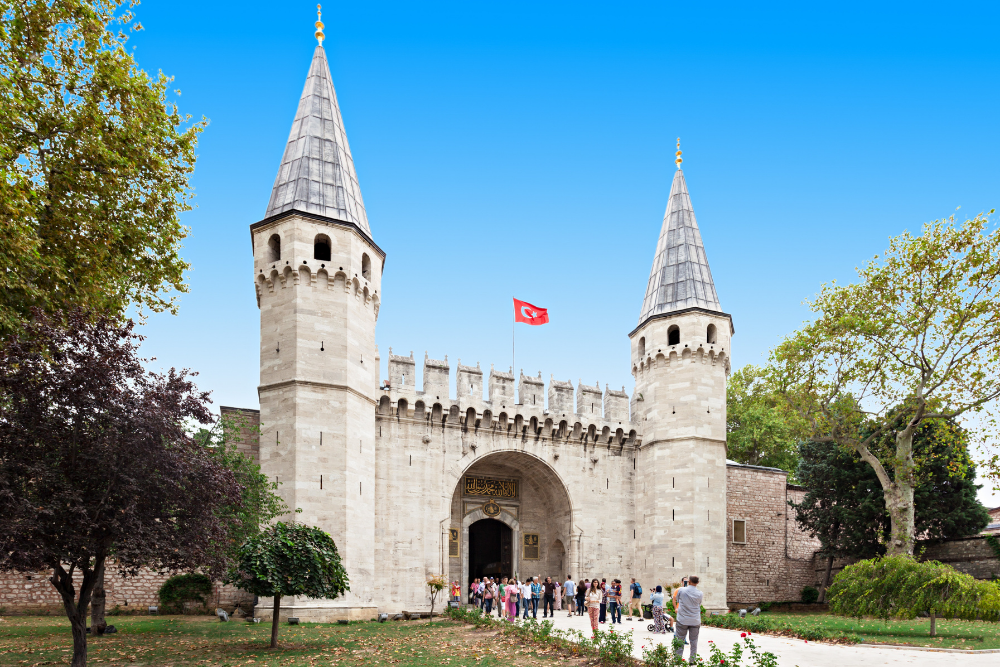Topkapi Palace is one of the most iconic landmarks in Istanbul, offering visitors a glimpse into the grandeur and opulence of the Ottoman Empire. As a former residence of the Ottoman sultans, this magnificent palace stands as a symbol of Istanbul’s rich history and cultural heritage. Perched on the tip of the historical peninsula, overlooking the Bosphorus and the Golden Horn, Topkapi Palace is not only a must-visit destination for tourists but also an important cultural and architectural masterpiece.
The History of Topkapi Palace
The construction of Topkapi Palace began in 1459 under the orders of Sultan Mehmed II, just a few years after the Ottoman Empire’s conquest of Constantinople. Originally known as the “New Palace,” it became the administrative center of the empire and the primary residence of the Ottoman sultans for nearly four centuries. Over time, the palace complex grew to include numerous courtyards, gardens, and pavilions, showcasing the wealth and power of the Ottoman dynasty.
Topkapi Palace served as the heart of Ottoman political and royal life until the mid-19th century when Sultan Abdülmecid I moved the royal residence to the newly built Dolmabahçe Palace. Despite this shift, Topkapi Palace remained a vital part of Ottoman life and was transformed into a museum in 1924, following the establishment of the Turkish Republic.

Architecture and Layout of Topkapi Palace
Topkapi Palace is an architectural marvel, blending traditional Ottoman design with influences from Persian, Islamic, and Byzantine styles. The palace is divided into four main courtyards, each offering a unique experience and insight into the life of the Ottoman court.
The First Courtyard: This is the largest and most public part of the palace, where visitors first enter through the Imperial Gate. Here, they can explore the Hagia Irene, a former church, and various administrative buildings.
The Second Courtyard: The heart of the palace’s administrative functions, the second courtyard includes the Imperial Council Hall and the palace kitchens. This area was the center of political and ceremonial life in the Ottoman Empire, where the sultan’s advisors would meet to discuss state affairs.
The Third Courtyard: This private section of the palace was reserved for the sultan and his family. It contains the Audience Chamber, where the sultan received guests, and the Palace School, where future administrators and military leaders were trained.
The Fourth Courtyard: Known for its stunning views over the Bosphorus and the Golden Horn, the fourth courtyard was a place of leisure for the sultan and his family. It features several pavilions, gardens, and the iconic Baghdad Pavilion, built to commemorate the Ottoman conquest of Baghdad.
The Harem: Life Behind Closed Doors One of the most intriguing and mysterious parts of Topkapi Palace is the Harem, where the sultan’s wives, concubines, and children lived.
The Harem was a private world, hidden from public view, and was governed by strict protocols and traditions. It was also the domain of the Queen Mother, the most powerful woman in the Ottoman Empire.
Visiting the Harem offers a rare glimpse into the private life of the Ottoman court, with its beautifully decorated rooms, intricate tile work, and luxurious furnishings. The rooms are adorned with Iznik tiles, stained glass windows, and marble columns, reflecting the opulence and refinement of the Ottoman period.
The Topkapi Palace Treasury: A Showcase of Ottoman Wealth
Another highlight of Topkapi Palace is the Treasury, where visitors can view some of the most valuable treasures of the Ottoman Empire. The collection includes priceless jewels, gold artifacts, and religious relics. Among the most famous items is the Topkapi Dagger, an ornate weapon encrusted with emeralds, and the Spoonmaker’s Diamond, one of the largest diamonds in the world.
The treasury also houses important relics of the Prophet Muhammad, including his cloak and sword, making it a significant site for Muslim pilgrims. These relics, along with the palace’s artifacts, offer a fascinating insight into the power and prestige of the Ottoman sultans.
Topkapi Palace Today: A Living Museum
Today, Topkapi Palace operates as a museum, attracting millions of visitors each year. It provides a unique opportunity to explore the rich history of the Ottoman Empire, while also offering breathtaking views of Istanbul’s skyline. Walking through its courtyards and chambers, visitors can immerse themselves in the splendor of a bygone era.
The palace’s location on the historical peninsula allows easy access to other major landmarks in the area, such as the Hagia Sophia, Blue Mosque, and Basilica Cistern. Its proximity to these sites makes Topkapi Palace a central stop on any tour of Istanbul.
Topkapi Palace is not just a relic of the past—it is a living testament to the grandeur and power of the Ottoman Empire. From its stunning architecture to its priceless treasures, every corner of the palace tells a story of Istanbul’s imperial history. For anyone visiting Istanbul, exploring Topkapi Palace is an essential experience, offering an unforgettable journey into the heart of Ottoman royalty and culture.


